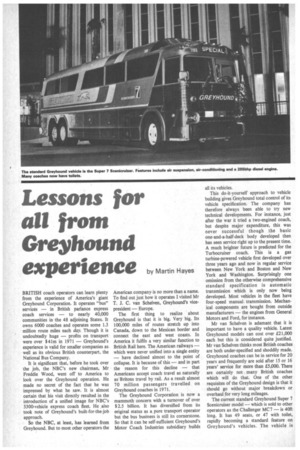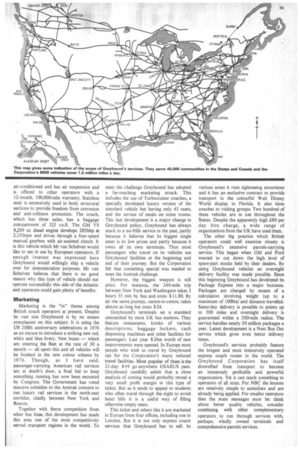• Lessons for all from Greyhound
Page 46

Page 47

If you've noticed an error in this article please click here to report it so we can fix it.
experience by Martin Hayes BRITISH coach operators can learn plenty from the experience of America's giant Greyhound Corporation. It operates "bus" services — in British parlance express coach services — to nearly 40,000 communities in the 48 adjoining States. It owns 6000 coaches and operates some 1.3 million route miles each day. Though it is undoubtedly huge — profits on transport were over $ 41m in 1971 — Greyhound's experience is valid for smaller companies as well as its obvious British counterpart. the National Bus Company.
It is significant that, before he took over the job. the NBC's new chairman. Mr Freddie Wood, went off to America to look over the Greyhound operation. He made no secret of the fact that he was impressed by what he saw. It is almost certain that his visit directly resulted in the introduction of a unified image for NBC's 3300-vehicle express coach fleet. He also took note of Greyhound's built-for-the-job approach.
So the NBC, at least, has learned from Greyhound. But to most other operators the American company is no more than a name. To find out just how it operates I visited Mr T. J. C. van Schelven, Greyhound's vicepresident — Europe.
The first thing to realize about Greyhound is that it is big. Very big. Its 100,000 miles of routes stretch up into Canada, down to the Mexican border and connect the east and west coasts. In America it fulfils a very similar function to British Rail here. The American railways — which were never unified into a single entity — have declined almost to the point of collapse. It is because of this — and in part the reason for this decline — that Americans accept coach travel as naturally as Britons travel by rail. As a result almost 70 million passengers travelled on Greyhound coaches in 1971.
The Greyhound Corporation is now a mammoth concern with a turnover of over $ 2.5 billion. It has diversified from its original status as a pure transport operator but the bus business is still its cornerstone. So that it can be self-sufficient Greyhound's Motor Coach Industries subsidiary builds all its vehicles.
This do-it-yourself approach to vehicle building gives Greyhound total control of its vehicle specification. The company has therefore always been able to try new technical developments. For instance, just after the war it tried a two-engined coach, but despite major expenditure, this was never successful though the basic one-and-a-half-deck body developed then has seen service right up to the present time. A much brighter future is predicted for the Turbocruiser coach. This is a gas turbine-powered vehicle first developed over three years ago and now in regular service between New York and Boston and New York and Washington. Surprisingly one omission from the otherwise comprehensive standard specification is automatic transmission which is only now being developed. Most vehicles in the fleet have four-speed manual transmission. Mechanical components are bought from outside manufacturers — the engines from General Motors and Ford, for instance.
Mr van Schelven is adamant that it is important to have a quality vehicle. Latest Greyhound models can cost over £21,000 each but this is considered quite justified. Mr van Schelven thinks most British coaches are both under-specified and shoddily made. Greyhound coaches can be in service for 20 years and frequently are sold after 15 or 16 years' service for more than £.5,000. There are certainly not many British coaches which will do that. One of the other requisites of the Greyhound design is that it should go without major breakdown or overhaul for very long mileages.
The current standard Greyhound Super 7 Scenicruiser model — which is sold to other operators as the Challenger MC7 — is 40ft long. It has 49 seats, or 47 with toilet, rapidly becoming a standard feature on Greyhound's vehicles. The vehicle is air-conditioned and has air suspension and is offered to other operators with a 12-month, 100,000-mile warranty. Stainless steel is extensively used in body structural sections to provide freedom from corrosion and anti-collision protection. The coach, which has three axles, has a baggage compartment of 325 cult. The GM VS 9,299 cc diesel engine develops 285bhp at 2,150rpm and drives through a four-speed manual gearbox with air-assisted clutch. It is this vehicle which Mr van Schelven would like to see in use by European operators. If enough interest was expressed here Greyhound would willingly ship a vehicle over for demonstration purposes. Mr van Schelven believes that there is no good reason why this type of vehicle should not operate successfully this side of the Atlantic and operators could gain plenty of benefits.
Marketing Marketing is the "in" theme among British coach operators at present. Despite its vast size Greyhound is by no means complacent on this subject. It is using the US 200th anniversary celebrations in 1976 as an excuse to introduce a striking new red, white and blue livery. New buses — which are entering the fleet at the rate of 30 a month — all sport this and all vehicles will be finished in the new colour scheme by 1976. Though, as I have said, passenger-carrying American rail services are at death's door, a final bid to keep something running has now been mounted by Congress. The Government has voted massive subsidies to the Amtrak concern to run luxury rail services in the north-east corridor, chiefly between New York and Boston.
Together with fierce competition from other bus linos, this development has made this area one of the most competitively served transport regions in the world. To meet the challenge Greyhound has adopted a far-reaching marketing attack. This includes the use of Turbocruiser coaches, a specially developed luxury version of the standard vehicle but having only 43 seats, and the service of meals on some routes. This last development is a,major change in Greyhound policy. Greyhound has always stuck to a no-frills service in the past, partly because it believes that its biggest single asset is its low prices and partly because it owns all its own terminals. Thus most passengers who travel on its vehicles use Greyhound facilities at the beginning and end of their journey. But the Corporation felt that something special was needed to meet the Amtrak challenge.
However, the biggest weapon is still price. For instance, the 240-mile trip between New York and Washington takes 3 hours 55 min by bus and costs $11.80. By air the same journey, centre-to-centre, takes almost as long but costs $ 24.
Greyhound's terminals set a standard unmatched by most UK bus stations. They feature restaurants, kiosks of various descriptions, baggage lockers, cash dispensing machines and other facilities for passengers. Last year $ 26m worth of new improvements were opened. In Europe most people who wish to travel by Greyhound opt for the Corporation's many reduced travel facilities. Most popular of thses is the 21-day $99 go-anywhere USABUS pass. Greyhound candidly admit that a close analysis of costing would probably reveal a very small profit margin in this type of ticket. But as it tends to appeal to students who often travel through the night to avoid hotel bills it is a useful way of filling otherwise empty seats.
This ticket and others like it are marketed in Europe from four offices, including one in London. But it is not only express coach services that Greyhound has to sell. In various areas it runs sightseeing excursions and it has an exclusive contract to provide transport in the colourful Walt Disney World display in Florida. It also hires coaches to visiting groups Two hundred of these vehicles are in use throughout the States. Despite the apparently high £80 per day hire charge, a wide range of organizations from the UK have used them.
The other big practice which British operators could well examine closely is Greyhound's extensive parcels-carrying service. This began when GM and Ford wanted to cut down the high level of spare-part stocks held by their dealers. By using Greyhound vehicles an overnight delivery facility was made possible. Since this beginning Greyhound has developed its Package Express into a major business. Packages are , charged by means of a calculation involving weight (up to a maximum of 1001bs) and distance travelled. Same-day delivery is possible to points up to 300 miles and overnight delivery is guaranteed within a 500-mile radius. The service handles nearly 50 million packages a year. Latest development is a Next Bus Out service which gives even better delivery times..
Greyhound's services probably feature the longest and most intensively operated express coach routes in the world. The Greyhound Corporation has itself diversified from transport to become an immensely profitable and powerful organization. Yet it can teach something to operators of all sizes. For NBC the lessons are relatively simple to assimilate and are already being applied. For smaller operators then the main messages must be: think about better quality vehicles, consider combining with other complementary operators to run through services with, perhaps, wholly owned terminals and comprehensive parcels services.




































































































